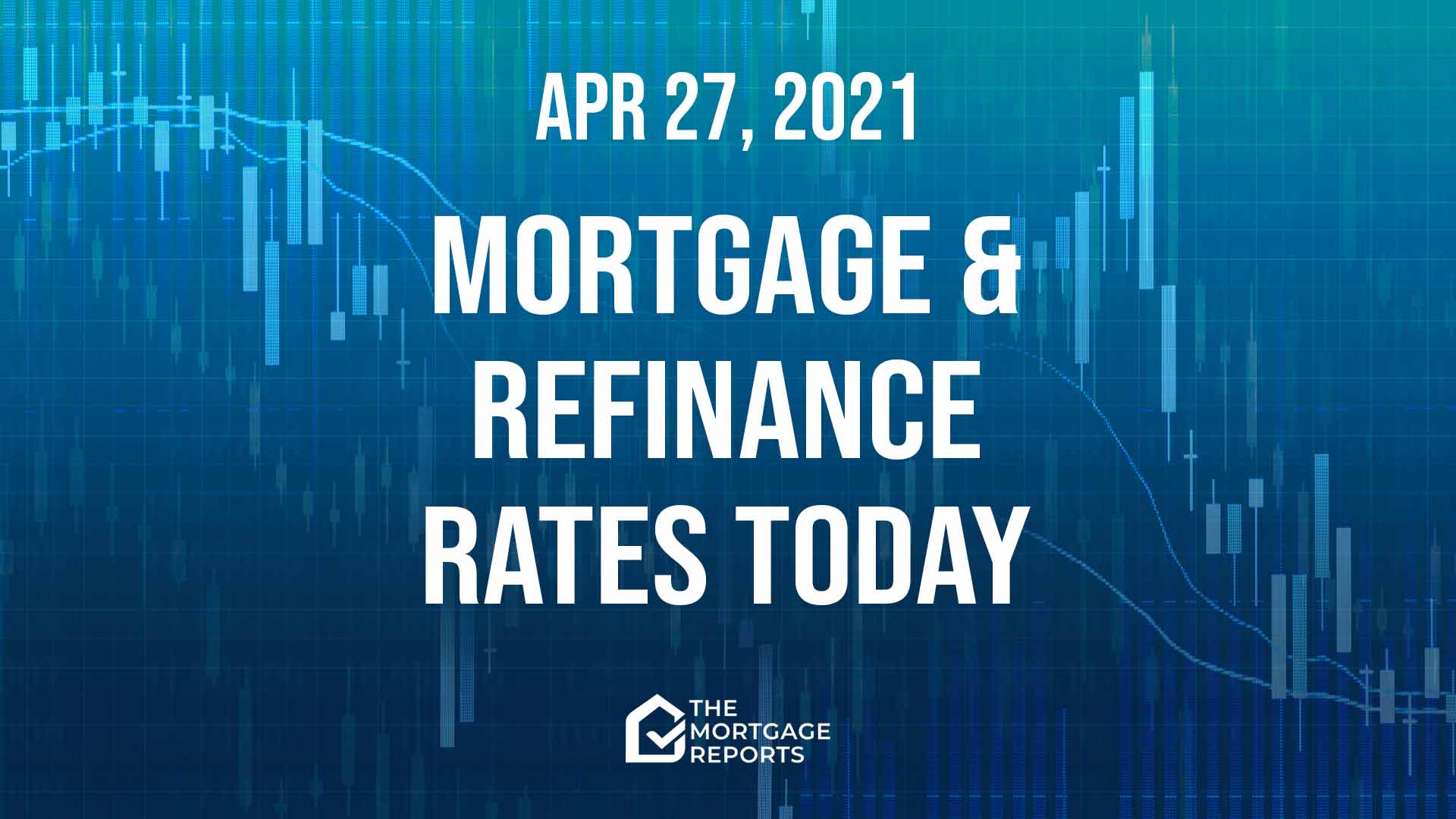
Today’s mortgage and refinance rates
Average mortgage rates inched higher yesterday. It was only the third rise in April. But also the third over the last seven working days. Still, falls are still easily outweighing increases.
First thing, it was looking as if mortgage rates today might inch higher again or hold steady.
Find and lock a low rate (Apr 27th, 2021)Current mortgage and refinance rates
| Program | Mortgage Rate | APR* | Change |
|---|---|---|---|
| Conventional 30 year fixed | |||
| Conventional 30 year fixed | 2.985% | 2.99% | Unchanged |
| Conventional 15 year fixed | |||
| Conventional 15 year fixed | 2.188% | 2.305% | +0.03% |
| Conventional 20 year fixed | |||
| Conventional 20 year fixed | 2.75% | 2.842% | Unchanged |
| Conventional 10 year fixed | |||
| Conventional 10 year fixed | 1.906% | 2.104% | -0.01% |
| 30 year fixed FHA | |||
| 30 year fixed FHA | 2.762% | 3.419% | +0.03% |
| 15 year fixed FHA | |||
| 15 year fixed FHA | 2.496% | 3.081% | +0.02% |
| 5 year ARM FHA | |||
| 5 year ARM FHA | 2.5% | 3.207% | Unchanged |
| 30 year fixed VA | |||
| 30 year fixed VA | 2.375% | 2.547% | Unchanged |
| 15 year fixed VA | |||
| 15 year fixed VA | 2.25% | 2.571% | Unchanged |
| 5 year ARM VA | |||
| 5 year ARM VA | 2.5% | 2.386% | Unchanged |
| Rates are provided by our partner network, and may not reflect the market. Your rate might be different. Click here for a personalized rate quote. See our rate assumptions here. | |||
COVID-19 mortgage updates: Mortgage lenders are changing rates and rules due to COVID-19. To see the latest on how coronavirus could impact your home loan, click here.
Should you lock a mortgage rate today?
April has seen mortgage rates falling slowly but steadily. According to Freddie Mac’s weekly figures, the average for 30-year, fixed-rate loans was 2.97% last week compared with 3.18% on March 31.
And yet all my mortgage lock recommendations have remained on Lock throughout. That’s because I’m fairly certain these rates will rise again, possibly sharply. (Read on for my reasons.) But I didn’t know — and still don’t know — when.
Feel free to continue to float while rates are going down. But be sure you can lock at the drop of a hat when the time comes. Because rises might be sharp then.
And, for now, my personal rate lock recommendations remain:
- LOCK if closing in 7 days
- LOCK if closing in 15 days
- LOCK if closing in 30 days
- LOCK if closing in 45 days
- LOCK if closing in 60 days
But I don’t claim perfect foresight. And your personal analysis could turn out to be as good as mine — or better. So you might choose to be guided by your instincts and your personal tolerance for risk.
Market data affecting today’s mortgage rates
Here’s a snapshot of the state of play this morning at about 9:50 a.m. (ET). The data, compared with roughly the same time yesterday, were:
- The yield on 10-year Treasurys rose to 1.59% from 1.57% (Bad for mortgage rates.) More than any other market, mortgage rates normally tend to follow these particular Treasury bond yields, though less so recently
- Major stock indexes were mixed on opening. (Neutral for mortgage rates.) When investors are buying shares they’re often selling bonds, which pushes prices of those down and increases yields and mortgage rates. The opposite happens when indexes are lower
- Oil prices rose to $62.49 from $61.35 a barrel. (Bad for mortgage rates*.) Energy prices play a large role in creating inflation and also point to future economic activity.
- Gold prices edged lower to $1,780 from $1,777 an ounce. (Neutral for mortgage rates*.) In general, it’s better for rates when gold rises, and worse when gold falls. Gold tends to rise when investors worry about the economy. And worried investors tend to push rates lower
- CNN Business Fear & Greed index — Held steady at 59 out of 100. (Neutral for mortgage rates.) “Greedy” investors push bond prices down (and interest rates up) as they leave the bond market and move into stocks, while “fearful” investors do the opposite. So lower readings are better than higher ones
Caveats about markets and rates
Before the pandemic and the Federal Reserve’s interventions in the mortgage market, you could look at the above figures and make a pretty good guess about what would happen to mortgage rates that day. But that’s no longer the case. We still make daily calls. And are usually right. But our record for accuracy won’t achieve its former high levels until things settle down.
So use markets only as a rough guide. Because they have to be exceptionally strong or weak to rely on them. But, with that caveat, so far mortgage rates today look likely to rise modestly or hold steady. Just be aware that intraday swings (when rates change direction during the day) are a common feature right now.
Find and lock a low rate (Apr 27th, 2021)
Important notes on today’s mortgage rates
Here are some things you need to know:
- Typically, mortgage rates go up when the economy’s doing well and down when it’s in trouble. But there are exceptions. Read ‘How mortgage rates are determined and why you should care
- Only “top-tier” borrowers (with stellar credit scores, big down payments and very healthy finances) get the ultralow mortgage rates you’ll see advertised
- Lenders vary. Yours may or may not follow the crowd when it comes to daily rate movements — though they all usually follow the wider trend over time
- When daily rate changes are small, some lenders will adjust closing costs and leave their rate cards the same
- Refinance rates are typically close to those for purchases. But some types of refinances are higher following a regulatory change
So there’s a lot going on here. And nobody can claim to know with certainty what’s going to happen to mortgage rates in coming hours, days, weeks, or months.
Are mortgage and refinance rates rising or falling?
Today and soon
Yesterday, we discussed the tension that investors are currently experiencing. On the one hand, they’re seeing exceptionally positive economic data here at home, including the Federal Reserve’s forecast of the fastest gross domestic product (GDP) growth since the Reagan presidency.
But, on the other hand, they’re witnessing the havoc still being wreaked by the COVID-19 pandemic in the economies (and, tragically, among the peoples) of some key trading partners. Those include India and Japan.
So far, they’ve prioritized the global problems over the evidence of the domestic economic recovery. And that’s why mortgage rates have been falling.
But how long can that last? Consumer spending makes up 70% of our GDP. And all the signs are that’s set to boom as the vaccine rollout emboldens people to shop, travel and eat out again.
I’m fairly confident that investors will have to respond to the domestic economy’s strength soon. And, when that happens, mortgage rates are almost bound to rise. But when the switch in focus from the global to the domestic will happen is anyone’s guess.
Of course, events might prove me wrong. And the domestic recovery could stall. Probably the most likely scenario for that would be the emergence of a new, vaccine-resistant variant of the coronavirus. So let’s hope I’m right — even if that means higher mortgage rates.
For more background on my wider thinking, read our latest weekend edition, which is published every Saturday soon after 10 a.m. (ET).
Recently
Over much of 2020, the overall trend for mortgage rates was clearly downward. And a new, weekly all-time low was set on 16 occasions last year, according to Freddie Mac.
The most recent weekly record low occurred on Jan. 7, when it stood at 2.65% for 30-year fixed-rate mortgages. But then the trend reversed and rates rose.
However, those rises were replaced by falls in April. And Freddie’s Apr. 22 report puts that weekly average at 2.97% (with 0.7 fees and points), down from the previous week’s 3.04%.
Expert mortgage rate forecasts
Looking further ahead, Fannie Mae, Freddie Mac and the Mortgage Bankers Association (MBA) each has a team of economists dedicated to monitoring and forecasting what will happen to the economy, the housing sector and mortgage rates.
And here are their current rates forecasts for the remaining quarters of 2021 (Q2/21, Q3/21, Q4/21) and the first quarter of 2022 (Q1/22).
The numbers in the table below are for 30-year, fixed-rate mortgages. Freddie’s were updated on April 14, Fannie’s on April 12 and the MBA’s on April 22.
| Forecaster | Q2/21 | Q3/21 | Q4/21 | Q1/22 |
| Fannie Mae | 3.2% | 3.3% | 3.4% | 3.5% |
| Freddie Mac | 3.2% | 3.3% | 3.4% | 3.5% |
| MBA | 3.4% | 3.6% | 3.7% | 3.9% |
However, given so many unknowables, the current crop of forecasts might be even more speculative than usual.
Find your lowest rate today
Some lenders have been spooked by the pandemic. And they’re restricting their offerings to just the most vanilla-flavored mortgages and refinances.
But others remain brave. And you can still probably find the cash-out refinance, investment mortgage or jumbo loan you want. You just have to shop around more widely.
But, of course, you should be comparison shopping widely, no matter what sort of mortgage you want. As federal regulator the Consumer Financial Protection Bureau says:
Verify your new rate (Apr 27th, 2021)Shopping around for your mortgage has the potential to lead to real savings. It may not sound like much, but saving even a quarter of a point in interest on your mortgage saves you thousands of dollars over the life of your loan.



